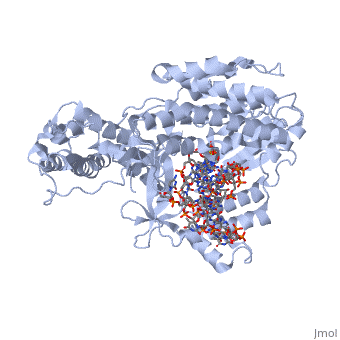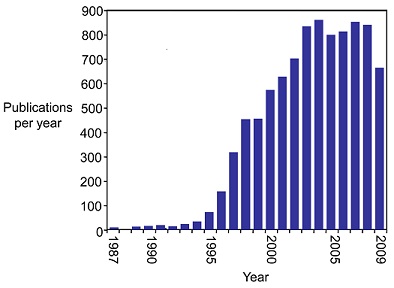Telomerase
From Proteopedia
(Difference between revisions)
| Line 1: | Line 1: | ||
<StructureSection load='3kyl' size='350' side='right' caption='Telomerase: bound to telomeric DNA [[3kyl]]' scene=''> | <StructureSection load='3kyl' size='350' side='right' caption='Telomerase: bound to telomeric DNA [[3kyl]]' scene=''> | ||
== Introduction == | == Introduction == | ||
| - | The telomerase is a complex composed of an RNA primer and protein that adds G-rich repeated DNA sequences to a 3' DNA strand in eukaryotic cells | + | The telomerase is a complex composed of an RNA primer and protein that adds G-rich repeated DNA sequences to a 3' DNA strand in eukaryotic cells <ref name='complex'>DOI: 10.1146/annurev.bi.61.070192.000553</ref>. This ribonucleoprotein acts as a reverse transcriptase that creates a DNA sequence complementary to its RNA primer in its catalytic subunit, TERT (2). The sequences attached to the end of DNA is non-coding DNA that functions as protection from mutation and degradation. As DNA replications occurs, the polymerase that copies in the 5' to 3' direction, cannot copy the end of the lagging strand which leaves unpaired bases that may code for a specific gene (3). Multiple unpaired ends can form hydrogen bonds or even swap genetic material. The telomerase fixes this issue and lengthens the strands, because the replication process slowly shortens the ends of chromosomes. This enzyme also plays a role in coordinating cell division. Complementary issues of aging and cancer describe the inactivation or over-activation of telomerase activity (3). |
== History == | == History == | ||
| Line 14: | Line 14: | ||
'''Overall Structure''' | '''Overall Structure''' | ||
| - | <scene name='60/602706/Telomerase/1'>Telomerase</scene> (protein in blue; RNA in green; DNA in red) acts as both a monomer and dimer. The monomer refers to the overall protein and its catalytic subunit TERT, made up of an amino acid polymer, containing approximately 5,000 atoms. This protein binds with the RNA template, <scene name='60/602706/Ter/1'>TER</scene>, that TERT uses to add DNA to form a dimer-like structure (4). The RNA has a molecular size between 200 and 500 kDA, depending on the organism | + | <scene name='60/602706/Telomerase/1'>Telomerase</scene> (protein in blue; RNA in green; DNA in red) acts as both a monomer and dimer. The monomer refers to the overall protein and its catalytic subunit TERT, made up of an amino acid polymer, containing approximately 5,000 atoms. This protein binds with the RNA template, <scene name='60/602706/Ter/1'>TER</scene>, that TERT uses to add DNA to form a dimer-like structure (4). The RNA has a molecular size between 200 and 500 kDA, depending on the organism <ref name='complex'>. Both the protein and RNA components are highly conserved structures among phylogenetic groups. <scene name='60/602706/Tert/2'>TERT</scene> is organized into a ring-like structure that shares common features with other reverse transcriptases (in viruses for example) and DNA polymerases. The RNA-DNA heteroduplex lies in the interior of the ring and positions the 3' end of the DNA primer at the active site to the telomerse can be enlongated. The substrate binding within the ring can accomodate 7 to 8 bases of double-stranded nucleic acid (4). |
'''Architecture of TERT Structure''' | '''Architecture of TERT Structure''' | ||
| - | <scene name='60/602706/Tert_catalytic_subunit/1'>TERT catalytic subunit</scene> contains 3 domains: reverse transcriptase domain (in green), and carboxy-terminal extension (CTE)(in blue), RNA binding domain (TRBD)(in red). Similar to its structural homologs, as noted above, the ring contains fingers, palm, and thumb sections (4). The reverse transcriptase domain represents the fingers and palm. It consists of a mixture of alpha helices and beta strands The TRBD domain is a helical structure that binds double and single stranded RNA, and is essential for RNP assembly and repeat addition processivity | + | <scene name='60/602706/Tert_catalytic_subunit/1'>TERT catalytic subunit</scene> contains 3 domains: reverse transcriptase domain (in green), and carboxy-terminal extension (CTE)(in blue), RNA binding domain (TRBD)(in red). Similar to its structural homologs, as noted above, the ring contains fingers, palm, and thumb sections (4). The reverse transcriptase domain represents the fingers and palm. It consists of a mixture of alpha helices and beta strands The TRBD domain is a helical structure that binds double and single stranded RNA, and is essential for RNP assembly and repeat addition processivity <ref name='RNP'>doi:10.1038/nsmb.1777</ref>. This fingers and palm is one of the most conserved portions across similar phylogeny. The thumb corresponds to the CTE, which is an elongated helical bundle that contains several surface-exposed long loops. Lastly, the TRBD is a helical structure that binds double and single stranded RNA. CTE and TRBD, the two terminal ends of the protein come together to form the ring-like structure <ref name='RNP'/>. |
== Active Site Chemistry == | == Active Site Chemistry == | ||
| Line 30: | Line 30: | ||
== References == | == References == | ||
| - | + | <references/> | |
| - | + | ||
2. Blackburn, Elizabeth H. "Telomeres and Telomerase: The Means to the End (Noble Lecture)." Angewandte Chemie International Edition 49 (2010): 7405-421. | 2. Blackburn, Elizabeth H. "Telomeres and Telomerase: The Means to the End (Noble Lecture)." Angewandte Chemie International Edition 49 (2010): 7405-421. | ||
| Line 38: | Line 37: | ||
4. Gillis, Andrew J., Anthony P. Schuller, and Emmanuel Skordalakes. "Structure of the Tribolium Castaneum Telomerase Catalytic Subunit TERT." Nature 455.7213 (2008): 633-37. Web. | 4. Gillis, Andrew J., Anthony P. Schuller, and Emmanuel Skordalakes. "Structure of the Tribolium Castaneum Telomerase Catalytic Subunit TERT." Nature 455.7213 (2008): 633-37. Web. | ||
| - | |||
| - | 5. Mitchell, Meghan, Andrew Gillis, Mizuko Futahashi, Haruhiko Fujiwara, and Emmanuel Skordalakes. "Structural Basis for Telomerase Catalytic Subunit TERT Binding to RNA Template and Telomeric DNA." Nature Structural & Molecular Biology 17.4 (2010): 513-18. Web. | ||
</StructureSection> | </StructureSection> | ||
Revision as of 08:39, 6 November 2014
| |||||||||||


